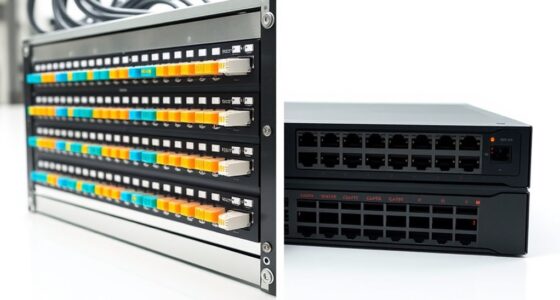Using VLANs, you can logically separate your IoT devices from your main home network, enhancing security and reducing the risk of malware spreading. By assigning IoT devices to dedicated VLANs, you control traffic flow and restrict access between segments. This setup limits potential damage if a device gets compromised and simplifies management. Continuing with this approach can give you even more tips to protect your network effectively.
Key Takeaways
- VLANs enable logical separation of IoT devices from main home networks for enhanced security and performance.
- Assign IoT devices to dedicated VLANs to restrict their access and prevent lateral movement of threats.
- Use VLANs to control and limit communication between home devices and IoT gadgets, reducing attack surfaces.
- Manage VLAN configurations easily via modern routers and switches without additional physical hardware.
- Segregating home and IoT networks with VLANs enhances overall security resilience and simplifies network management.

In today’s connected homes, separating your IoT devices from your main network is essential for security and performance. One effective way to achieve this is through network segmentation using VLANs. Virtual LANs allow you to logically divide your network into separate segments, ensuring that your smart devices, cameras, and other IoT gadgets don’t have direct access to your primary devices like computers and smartphones. This separation reduces the risk of security breaches and prevents potential malware from spreading across your entire network.
By implementing VLANs, you create distinct environments within your home network, each with its own rules and access controls. You can assign your IoT devices to a dedicated VLAN, isolating them from your main network. This device isolation ensures that even if an IoT device gets compromised, the attacker can’t easily access your personal data or other critical devices. It’s like placing your IoT gadgets behind a virtual barrier, making it much harder for threats to move laterally within your network.
Segregate IoT devices with VLANs to prevent lateral movement and protect your critical data.
Network segmentation with VLANs is particularly effective because it allows you to control traffic flow between different segments. You can restrict or allow communication based on your preferences, giving you granular control over what devices can interact. For example, you might allow your security cameras to send footage to a dedicated storage server but block them from accessing your personal computers. This setup minimizes potential attack vectors and limits the damage if one device is compromised.
Configuring VLANs also simplifies network management. Instead of physically segregating devices with multiple routers or switches, you can logically group devices on your existing network infrastructure. Many modern routers and managed switches support VLAN configuration through their admin interfaces, making it straightforward to set up and modify as your home network evolves. This flexibility ensures you can adapt your network segmentation strategy as your needs change, adding new IoT devices without compromising your security.
Additionally, leveraging network segmentation benefits can enhance overall network resilience and security posture.
Frequently Asked Questions
Can VLANS Improve Overall Network Security?
Yes, VLANs can improve your network security by enabling network segmentation, which isolates different device groups. This setup limits the spread of potential threats, such as malware or intrusions, by preventing them from reaching other parts of your network. With threat isolation through VLANs, you can better control access, reduce vulnerabilities, and protect sensitive data, making your overall network more secure and resilient against attacks.
What Are the Hardware Requirements for VLAN Setup?
Imagine a fortress guarding your digital domain; that’s what VLAN hardware provides. You’ll need a managed switch that supports VLAN tagging and network segmentation, enabling you to create separate virtual networks. A compatible router is essential for inter-VLAN routing, and proper network cables connect everything securely. Investing in these components ensures your VLAN setup is robust, empowering you to control traffic flow and protect your devices with confidence and clarity.
How Do VLANS Impact Network Performance?
VLANs improve your network performance by enabling better network segmentation, which isolates traffic and reduces congestion. They help you manage bandwidth more effectively by prioritizing critical devices and limiting unnecessary data flow. This targeted approach minimizes latency and enhances overall speed. By segmenting your network, you also improve security, preventing IoT devices from impacting your main network’s performance, ensuring a smoother, more efficient experience for all your connected devices.
Is Professional Assistance Necessary for VLAN Configuration?
You don’t necessarily need professional help to set up VLANs, but it can be beneficial if you want to separate guest networks or prioritize traffic flow effectively. A professional can guarantee proper configuration, avoiding issues like network bottlenecks or security gaps. If you’re comfortable with networking concepts, you might handle it yourself, but for seamless, secure separation of guest networks and ideal traffic flow, expert assistance is often worth it.
Can VLANS Be Used With Wireless Devices?
Yes, VLANs can be used with wireless devices. Wireless segmentation through VLAN compatibility is common, allowing you to separate your network traffic for security and performance. You’ll need a wireless access point that supports VLAN tagging, enabling you to assign wireless clients to specific VLANs. This setup helps isolate your IoT devices from your main network, improving security while maintaining seamless wireless connectivity.
Conclusion
By separating your home and IoT devices with VLANs, you create a security barrier that’s as effective as a fortress wall. This setup keeps your sensitive data safe and prevents potential breaches from IoT vulnerabilities. Think of VLANs as a smart gatekeeper, controlling access like a vigilant guard. Implementing this simple network segmentation is a proactive step that adds layers of protection, giving you peace of mind in today’s increasingly connected world.









